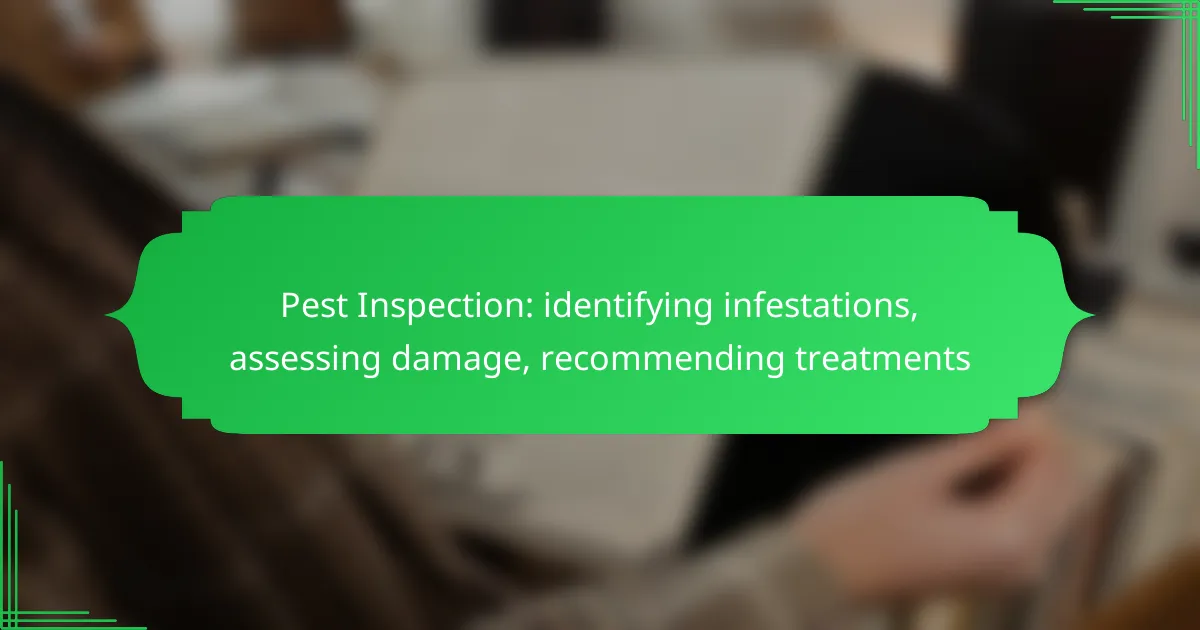Pest inspection is a critical process that involves identifying infestations, assessing damage, and recommending effective treatments. Utilizing methods such as visual inspections, thermal imaging, and moisture meters, professionals can detect early signs of pest activity, which is essential for minimizing property damage. A systematic approach ensures a thorough evaluation, leading to tailored pest management strategies that address specific issues effectively.
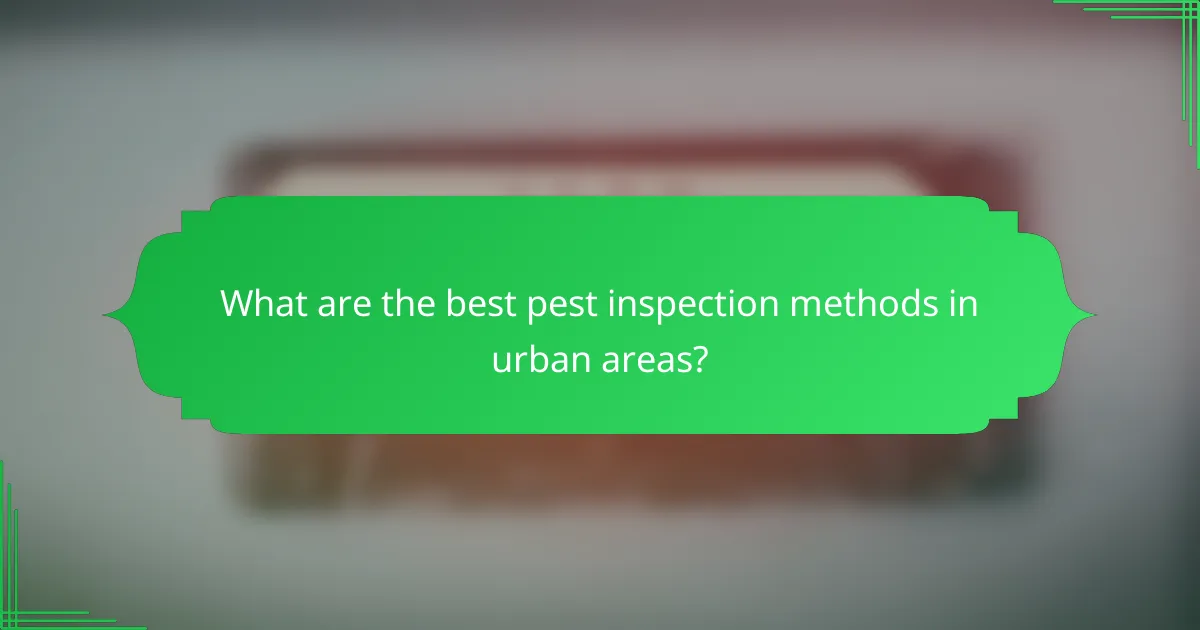
What are the best pest inspection methods in urban areas?
The best pest inspection methods in urban areas include visual inspections, thermal imaging, moisture meters, and traps. Each method has its strengths and is often used in combination to effectively identify infestations and assess damage.
Visual inspection techniques
Visual inspection techniques involve a thorough examination of the property for signs of pests, such as droppings, nests, or damage. Inspectors typically check common entry points, such as doors, windows, and cracks in the foundation.
To enhance effectiveness, inspectors should use a flashlight and magnifying glass, focusing on hidden areas like attics, basements, and behind appliances. Regular inspections can help catch infestations early, preventing more extensive damage.
Thermal imaging technology
Thermal imaging technology detects temperature variations that may indicate pest activity, such as nests in walls or moisture from leaks. This non-invasive method allows inspectors to identify problem areas without damaging the property.
While thermal imaging can be highly effective, it is best used in conjunction with other methods, as it may not pinpoint the exact type of pest. Inspectors should be trained in interpreting thermal images to maximize accuracy.
Moisture meters usage
Moisture meters measure the moisture levels in walls, floors, and other surfaces, helping to identify conditions conducive to pest infestations, particularly termites and mold. High moisture levels can indicate leaks or poor ventilation.
Using a moisture meter can guide inspectors to areas that require further investigation. Regular monitoring can help property owners maintain a dry environment, reducing the likelihood of pest problems.
Traps and monitoring devices
Traps and monitoring devices are essential tools for detecting and managing pest populations. Sticky traps can capture rodents and insects, while bait stations can help monitor and control infestations.
Setting traps in strategic locations, such as near entry points or suspected nesting areas, increases their effectiveness. Regularly checking and maintaining these devices is crucial for timely intervention and pest management.
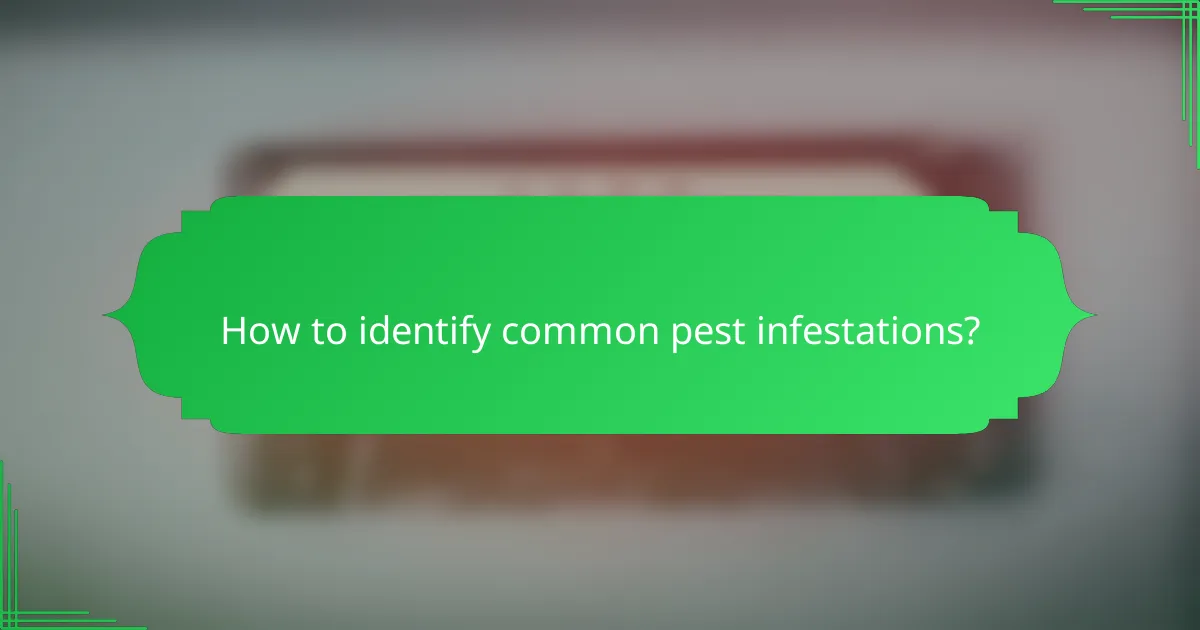
How to identify common pest infestations?
Identifying common pest infestations involves recognizing specific signs and symptoms associated with various pests. Early detection is crucial for effective treatment and minimizing damage to your property.
Signs of rodent infestations
Rodent infestations can be identified by droppings, gnaw marks, and nests made from shredded materials. Look for small, dark pellets in areas where food is stored or along walls.
Additionally, listen for scratching sounds in walls or ceilings, especially at night when rodents are most active. If you notice these signs, it’s essential to act quickly to prevent further damage and health risks.
Identifying termite damage
Termite damage is often indicated by hollow-sounding wood, mud tubes along walls, and discarded wings near windows or doors. Inspect wooden structures for soft spots or frass, which resembles sawdust.
Regular inspections, especially in regions prone to termites, can help catch infestations early. If you suspect termite activity, consider consulting a pest control professional for a thorough assessment.
Recognizing bed bug presence
Bed bugs are typically identified by small, reddish-brown stains on bedding or mattress seams, which are remnants of their feeding. You may also find tiny eggs or shed skins in these areas.
Look for bite marks on your skin, often appearing in clusters or lines. If you experience unexplained bites or see these signs, it’s crucial to seek treatment promptly, as bed bugs can spread quickly throughout your home.
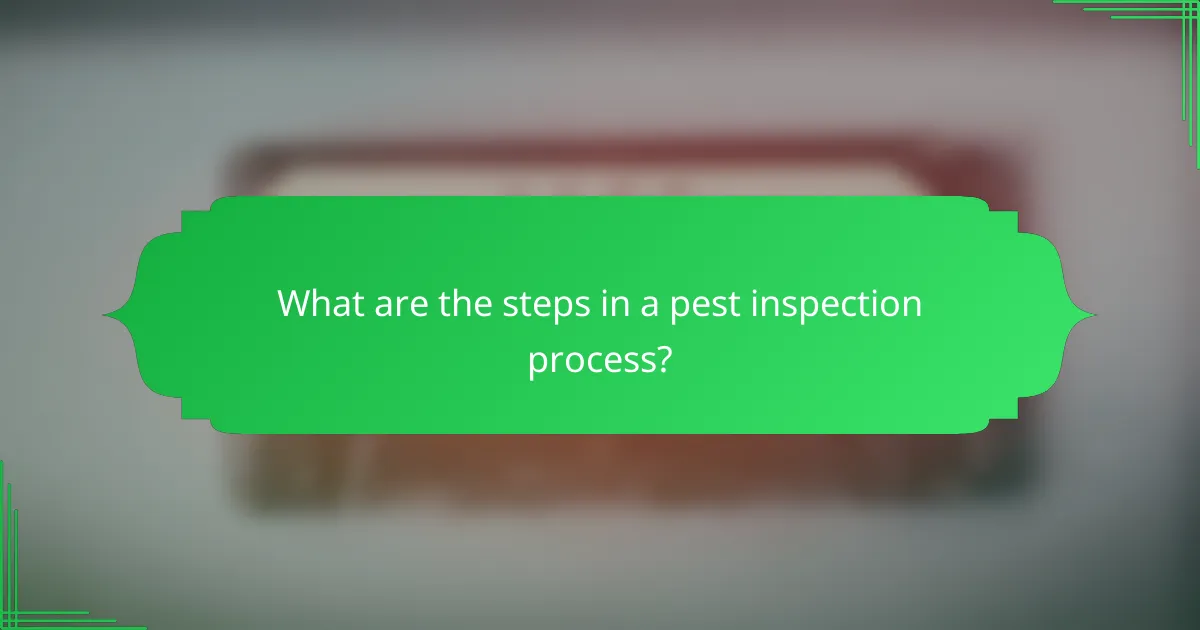
What are the steps in a pest inspection process?
The pest inspection process involves several key steps to identify infestations, assess damage, and recommend appropriate treatments. This systematic approach ensures thorough evaluation and effective pest management strategies.
Initial consultation overview
The initial consultation is the first step in the pest inspection process, where the inspector gathers information about the property and any pest-related concerns. Homeowners should provide details about previous pest issues, visible signs of infestation, and any specific areas of concern.
This phase often includes a discussion of the property’s history, including any recent renovations or changes that may affect pest activity. Clear communication helps set expectations for the inspection and treatment process.
Site assessment procedures
During the site assessment, the inspector conducts a thorough examination of the property, both inside and outside. This includes checking common entry points such as windows, doors, and vents, as well as inspecting basements, attics, and crawl spaces for signs of pests.
Inspectors look for droppings, nests, and damage to structures or belongings. They may also evaluate environmental factors that could contribute to infestations, such as moisture levels and food sources. This comprehensive assessment is crucial for determining the extent of the problem.
Reporting findings
After completing the inspection, the inspector compiles a detailed report outlining their findings. This report typically includes identified pest species, the severity of the infestation, and any damage observed. It serves as a critical tool for homeowners to understand the situation.
The report will also recommend treatment options tailored to the specific pest issues identified. Homeowners should review this information carefully and discuss any questions with the inspector to ensure they understand the proposed solutions and next steps.
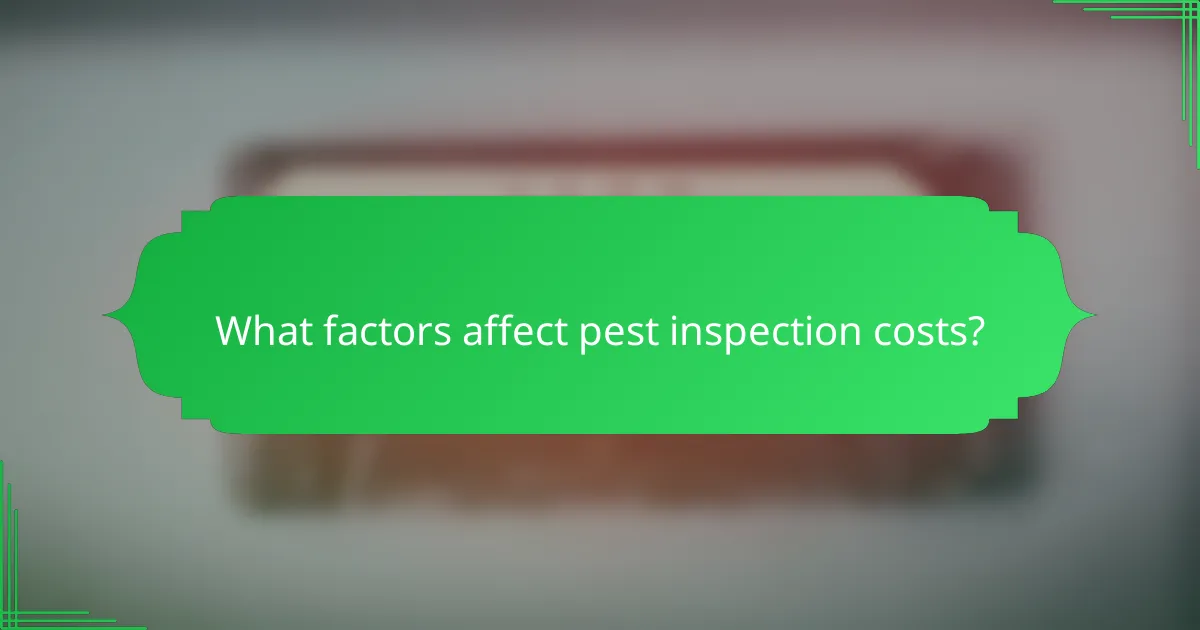
What factors affect pest inspection costs?
Pest inspection costs can vary significantly based on several key factors, including the size of the property, the types of pests involved, and the geographic location. Understanding these elements can help homeowners and property managers budget appropriately for pest inspections.
Property size considerations
The size of the property is a major factor in determining pest inspection costs. Larger properties typically require more time and resources to inspect, leading to higher fees. For instance, inspections for small homes might range from $100 to $300, while larger commercial buildings could cost several hundred to over a thousand dollars.
When budgeting for pest inspections, consider the square footage and the complexity of the layout. Properties with multiple levels or extensive outdoor areas may incur additional charges due to the increased labor involved.
Type of pests involved
The type of pests being inspected can significantly influence the cost of the inspection. Common pests like ants and termites may have standard inspection fees, while specialized pests such as bed bugs or rodents might require more thorough assessments, increasing costs. For example, a standard inspection for termites may cost around $150, whereas a bed bug inspection could be upwards of $300 due to the need for specialized techniques.
Additionally, if a property has a history of severe infestations, it may require more extensive inspections, which can further elevate costs. Always inquire about the specific pests being targeted to get a clearer estimate.
Geographic location impact
The geographic location of a property can greatly affect pest inspection costs due to variations in local demand, regulations, and the prevalence of certain pests. Urban areas often have higher costs due to increased competition and demand for pest control services, while rural areas may offer lower rates.
Moreover, certain regions may have specific pest issues that require specialized knowledge, influencing the pricing structure. For instance, areas prone to termite infestations may have more pest control companies specializing in that service, potentially leading to competitive pricing.
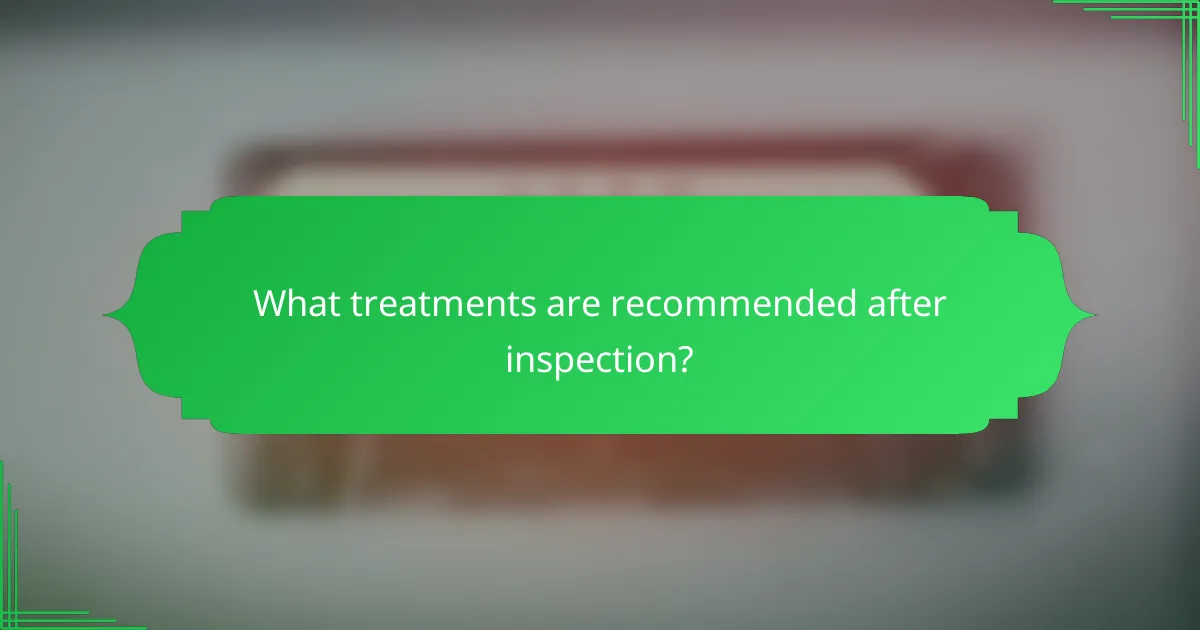
What treatments are recommended after inspection?
After a pest inspection, recommended treatments typically include a combination of Integrated Pest Management (IPM) strategies and chemical treatment options. The choice of treatment depends on the type of infestation, the extent of damage, and the specific environment.
Integrated Pest Management (IPM) strategies
IPM strategies focus on long-term prevention and control of pests through a combination of techniques. This approach includes monitoring pest populations, identifying their natural enemies, and using cultural, physical, and biological controls to minimize infestations.
For example, sealing entry points, maintaining cleanliness, and using traps can significantly reduce pest populations without relying solely on chemicals. IPM also emphasizes the importance of educating property owners about pest behavior and prevention methods.
Chemical treatment options
Chemical treatments may be necessary for severe infestations and typically involve the use of pesticides. These products can be categorized into insecticides, herbicides, and fungicides, each targeting specific pests or problems.
When considering chemical options, it’s crucial to select products that are approved for use in residential or commercial settings, following local regulations. Always follow label instructions for safe application and consider hiring a licensed pest control professional to ensure effective treatment.
